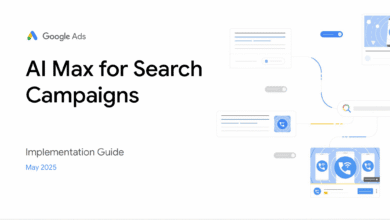Google’s AI Max: How the New Ad Tool Works

▼ Summary
– AI Max automates and optimizes ad campaigns using advanced machine learning while addressing advertiser concerns about control and transparency.
– It expands ad reach beyond manual keyword bids by analyzing intent and context to connect ads with relevant searches dynamically.
– Dynamic creative optimization tailors ad copy and landing pages in real-time based on user behavior and predicted conversion likelihood.
– Ideal for standard Search campaign advertisers, especially those new to Performance Max, with optional A/B testing for cautious adopters.
– Maintains brand consistency by generating creatives from existing assets while prioritizing high-converting traffic for budget efficiency.
Google’s latest AI-powered advertising tool, AI Max, is transforming how businesses approach search campaigns by combining automation with intelligent targeting. The platform leverages advanced machine learning to optimize ad performance while addressing common advertiser concerns about control and transparency.
At its core, AI Max represents Google’s push toward more sophisticated, intent-based advertising that goes beyond traditional keyword matching. The system analyzes multiple data points to connect ads with relevant searches, even those not explicitly targeted in campaigns. This includes dynamically adjusting ad copy and automatically directing users to the most appropriate landing pages based on their search behavior.
Key capabilities advertisers should understand:
- Expanded reach beyond manual keyword bids while maintaining relevance
- Dynamic creative optimization that tailors messaging in real-time
- Smart landing page selection based on predicted conversion likelihood
Google has provided specific guidance for marketers considering the transition:
Who benefits most? The tool appears ideal for advertisers running standard Search campaigns who haven’t yet adopted Performance Max. Activating all three core functions – expanded targeting, dynamic ads, and automated landing pages – reportedly delivers optimal results, though advertisers can test individual components.
For those cautious about relinquishing control, A/B testing remains available through Google’s experiment framework. This allows side-by-side comparisons between AI-enhanced and traditional campaign approaches. The system also incorporates safeguards against wasted spend by prioritizing traffic likely to convert based on campaign objectives.
How AI Max builds ads: The technology draws from existing campaign assets, website content, and landing pages to generate new creative elements. This addresses concerns about brand consistency while still allowing for automated optimization.
The future of keyword targeting: Rather than eliminating keywords entirely, AI Max works alongside them, using contextual signals to identify additional relevant queries. This “keywordless” approach analyzes user intent and content meaning to expand reach without sacrificing relevance.
For advertisers weighing adoption, Google’s clarifications help demystify how much oversight remains when using these automated tools. The platform appears designed to enhance performance while maintaining safeguards for brand safety and budget efficiency – critical considerations for any marketing team evaluating new technology.
(Source: Search Engine Land)
